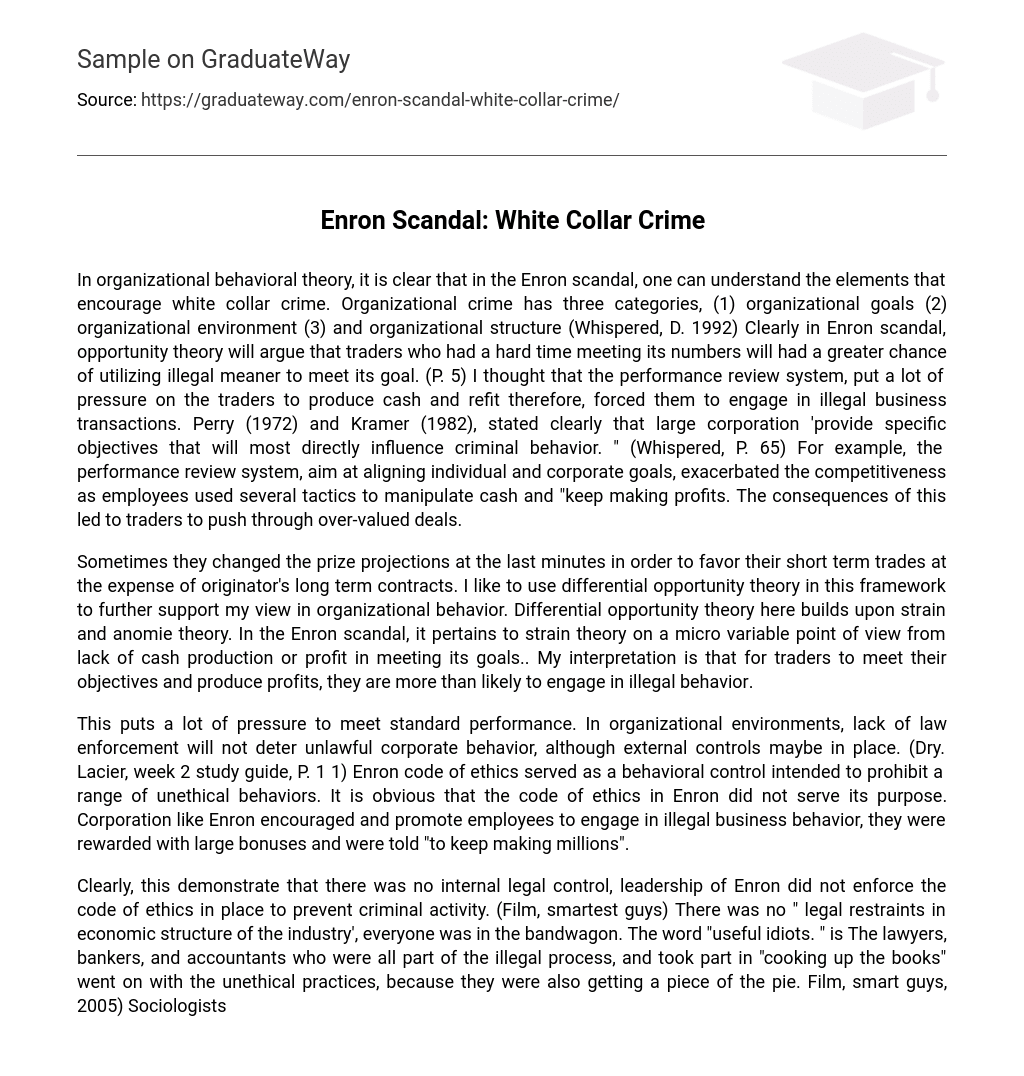In organizational behavioral theory, it is evident that the Enron scandal offers insight into the factors that promote white collar crime. Organizational crime encompasses three main aspects: (1) organizational goals, (2) organizational environment and (3) organizational structure (Whispered, D. 1992). In the case of the Enron scandal, opportunity theory suggests that traders who struggled to achieve their targets were more likely to resort to illegal methods to meet their goals (P. 5). I believed that the performance review system placed significant pressure on traders to generate cash and profits, thereby compelling them to partake in illicit business transactions. Perry (1972) and Kramer (1982) clearly explained how large corporations establish specific objectives that have a direct impact on criminal behavior (Whispered, P. 65). For instance, the performance review system aimed to align individual and corporate objectives, intensifying competitiveness among employees who employed various strategies to manipulate cash and maintain profitability. As a result, traders were driven to execute overvalued deals.
Sometimes, they alter the prize projections at the last moment to benefit their short-term trades at the expense of the originator’s long-term contracts. I utilize differential opportunity theory within this framework to further substantiate my perspective on organizational behavior. In this context, differential opportunity theory expands upon strain and anomie theory. Within the Enron scandal, it relates to strain theory at a micro level regarding the lack of cash production or profit in achieving its objectives. My understanding is that traders are highly likely to engage in unlawful conduct in order to fulfill their goals and generate profits.
This puts a lot of pressure to meet standard performance. In organizational environments, lack of law enforcement will not deter unlawful corporate behavior, although external controls maybe in place. (Dry. Lacier, week 2 study guide, P. 1 1) Enron code of ethics served as a behavioral control intended to prohibit a range of unethical behaviors. It is obvious that the code of ethics in Enron did not serve its purpose. Corporation like Enron encouraged and promote employees to engage in illegal business behavior, they were rewarded with large bonuses and were told “to keep making millions”.
Clearly, this demonstrates that there was a lack of internal legal control at Enron. The leadership did not enforce the existing code of ethics, which was intended to prevent criminal activity. According to the film “The Smartest Guys in the Room”, there were no legal restraints in the economic structure of the industry, and everyone was involved. The term “useful idiots” refers to the lawyers, bankers, and accountants who participated in the illegal processes and unethical practices, as they also benefited from it. (Film, The Smartest Guys in the Room, 2005) Sociologists have analyzed various factors within organizations that may encourage criminal behavior, such as size, internal control structures, and subcultures. (Whispered, P. 68) Lane (1954) found that firm size can have contradictory effects on criminality depending on the industry and type of violations. Their research concluded that there is no clear relationship between the size of a corporation and its violations. (P. 58) Clarinda and Yeager (1980, P. 130) as well as Breathiest (1984, 1989) supported the idea that institutions with formal compliance divisions are more likely to ensure that corporations abide by the law.
P. 69) In the case of Enron, we observed that multiple executives, including CEO Ana, did not establish proper standards for employees to adhere to. Enron exemplified a culture fueled by greed and corruption. Within this context, employees who declined to engage in illegal trades or failed to meet expectations faced a higher risk of losing their jobs. This practice was known as “Weed the Weak,” implying that individuals who did not generate profits would be eliminated or transferred.
The Enron scandal was driven by large bonuses used as incentives for high performance and the desire to please higher-ups, which I believe was more focused on the macro level rather than the micro. The individuals involved in the scandal exhibited various characteristics, such as charisma, a need for control, and a tendency to bully subordinates by utilizing tactics to ensure compliance. Subordinates were afraid of losing their status or position, while employees lacked a sense of integrity, among other traits. Overall, it seems that the Enron scandal can be seen as consisting of two main groups: leaders and followers.
In my opinion, leaders like Ken Lay and Killing were arrogant and felt entitled, engaging in rationalization. I believed that the followers shared the same personality traits and motivations for profit and greed. References: Frederic’s, D. (2010) Trusted Criminals, White Collar Crimes (4th De.) Headwords, Coinage Learning Whispered. D. Schlemiel, K. (1992) White Collar Crime Reconsidered, North Western University Press, Boston Dry. Lacier (week, study guide, September 10, 2013) CO 632 White Collar Crime Enron the smartest guys in the room, (2005) Magnolia Home Entertainment.





